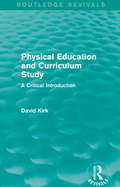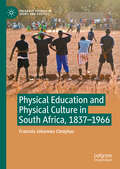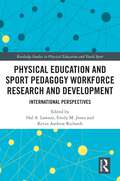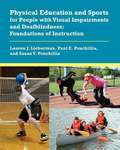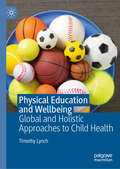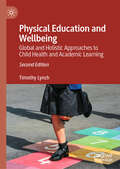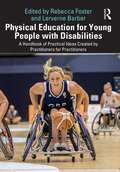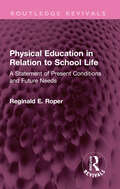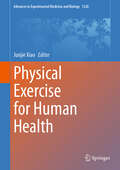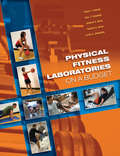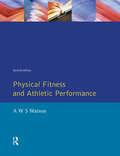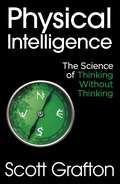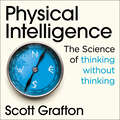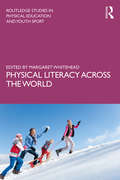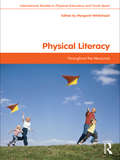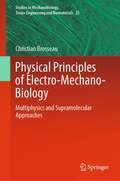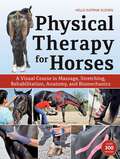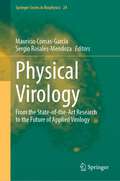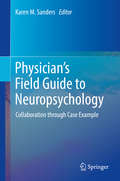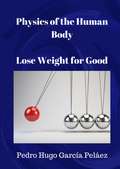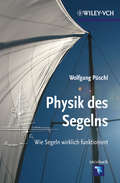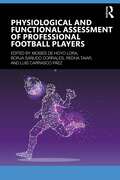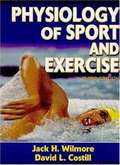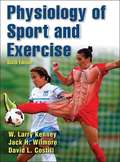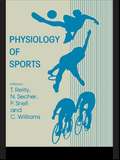- Table View
- List View
Physical Education and Curriculum Study: A Critical Introduction (Routledge Revivals)
by David KirkThe Curriculum is the focal point for the study of educational practice. It is the area in which individual, group and societal needs and interests meet and is consequently the source of much friction and contention. This book, first published in 1988, introduces students to some of the major points of debate; in particular, the role of curriculum-based study in the development of physical education and the credibility of the subject as an educational activity. David Kirk emphasises the beneficial effects of physical education and suggests ways in which instructive programmes can be created. A practical and interesting title, this reissue will be of particular value to students and teachers of sport science, and educational practitioners more generally.
Physical Education and Physical Culture in South Africa, 1837-1966 (Palgrave Studies in Sport and Politics)
by Francois Johannes CleophasThe interconnectedness between sport and colonialism has long been a matter of interest to sport historians. Consequently, a large number of scholarly works exist on physical education and physical culture history, but there is no significant work on this within a South African context, both nationally and at community level. This book therefore provides the first historical account of physical education and physical culture in Cape Town, South Africa and its surrounding areas in the Western Cape.
Physical Education and Sport Pedagogy Workforce Research and Development: International Perspectives (Routledge Studies in Physical Education and Youth Sport)
by Hal A. Lawson Kevin Andrew Richards Emily M. JonesThis is the first book to examine physical education from the perspective of workforce research and development. It adopts a whole system approach—including schools, higher education and public policy—to advance an action‑oriented framework for meeting the needs, challenges and opportunities of the global physical education profession.Presenting a new framework for research and continuous improvement, this book focuses on the physical education workforce, and the workforce system, as a key social determinant of new program design and implementation, and therefore of better outcomes for children and young people. Including the voices of higher education faculty, in-service physical education practitioners and professional association leaders, this book explains how specialized workforce components such as teacher education, school programs, doctoral programs and public policy are inter‑related, and takes a close look at how a workforce R&D approach can shine new light on physical education across the globe, including in-depth case studies from North and South America, Europe, Asia and Oceania. The final section of this book presents comparative analysis, considers lessons learned and outlines an agenda, which will empower readers to participate in and lead workforce development initiatives.Combining practical guidance and thorough research, this book is fascinating reading for any advanced student, researcher, in‑service teacher or policymaker with an interest in physical education, coaching children in sport, teacher education, international education or education policy.
Physical Education and Sports for People with Visual Impairments and Deafblindness
by Lauren J. Lieberman Paul E. Ponchillia Susan V. PonchilliaPhysical education teachers, adapted physical education teachers, and activity leaders in the trenches are always on the lookout for new, appropriate, and appealing games and activities for their students. When it comes to working with individuals who are visually impaired or deafblind, however, most of them confront what may seem like a greater challenge: how to in¬clude these students in physical activities and adapt activities so that they may participate fully along with others. In Physical Education and Sports for People with Visual Impairments and Deafblindness: Foundations of Instruction, Lauren Lieberman, Paul Ponchillia, and Susan Ponchillia contribute compelling resources for these efforts and for these professionals, as well as for recreational therapists, physical therapists, teachers of students with visual impairments or deafblindness, and anyone concerned with the full inclusion of children and adults who are visually impaired in athletics and the other essential activities of life.
Physical Education and Wellbeing: Global and Holistic Approaches to Child Health
by Timothy LynchThis book explores how physical education (PE) can be best enacted in primary schools in order to optimise children’s wellbeing. Drawing together extensive data from school communities around the globe, the author examines multiple dimensions of child health in practice. Ultimately, the findings suggest that PE is imperative within the wider landscape of children’s holistic learning, offering a powerful platform for meaningful connections across learning areas. While quantitative research has long evidenced the benefits of physical activity, this book contributes to the complex and global issue of what effective health and wellbeing approaches look like in practice. It is natural for children to enjoy movement for the purposes of play, exploration, learning and development: this book is essential reading for educators looking to enhance children’s wellbeing and general health.
Physical Education and Wellbeing: Global and Holistic Approaches to Child Health and Academic Learning
by Timothy LynchThis book, now in its second edition, explores how physical education (PE) and learning through movement can be best enacted in schools in order to optimise children's wellbeing and subsequent academic learning. Drawing together extensive data from school communities around the globe, the author examines multiple dimensions of child health in practice. Ultimately, the findings suggest that PE is imperative within the wider landscape of children’s holistic learning, offering a powerful platform for meaningful connections across learning areas. While quantitative research has long evidenced the benefits of physical activity, this book contributes to the complex and global issue of what effective health and wellbeing approaches look like in practice, offering clear strategies for optimising children’s academic learning. It is natural for children to enjoy movement for the purposes of play, exploration, learning and development; this book is essential reading for scholars (professors, researchers and students), school leaders and educators looking to enhance children’s wellbeing, general health and academic learning.
Physical Education for Young People with Disabilities: A Handbook of Practical Ideas Created by Practitioners for Practitioners
by Rebecca Foster Lerverne BarberPhysical Education for Young People with Disabilities explores a range of methods that will support teachers to be more inclusive in their practice when planning and teaching Physical Education. Offering many practical ideas to include pupils with specific additional needs across a range of activity areas, such as athletics, dance, gymnastics and swimming, this book will increase practitioners' confidence, enabling them to feel equipped to meet individual needs and include all pupils in their lessons. The range of authors provides a wide perspective and wealth of experience, and all the ideas have been trialled with students and young people, both nationally and internationally.Written by practitioners for practitioners, this book is a valuable resource for trainee teachers, in-service teachers and practitioners working in a practical or sporting context with young people, and will support Physical Education lessons and physical activity sessions.
Physical Education in Relation to School Life: A Statement of Present Conditions and Future Needs (Routledge Revivals)
by Reginald E. RoperFirst published in 1917, Physical Education in Relation to School Life views the problems of growth and health in relation to education. The main outlines of a satisfactory physical education and its importance are indicated. The author has compared his aims and objectives, and appreciated the practical value of some of the better-known methods of dealing with the problems, and has suggested the direction in which future improvements may most usefully be sought. This book will be of interest to students of physical education, pedagogy and history.
Physical Exercise for Human Health (Advances in Experimental Medicine and Biology #1228)
by Junjie XiaoThis book shares the latest findings on exercise and its benefits in preventing and ameliorating numerous diseases that are of worldwide concern. Addressing the role of exercise training as an effective method for the prevention and treatment of various disease, the book is divided into eleven parts: 1) An Overview of the Beneficial Effects of Exercise on Health and Performance, 2) The Physiological Responses to Exercise, 3) Exercise and Metabolic Diseases, 4) Exercise and Cardiovascular Diseases, 5) Exercise and Musculoskeletal Diseases, 6) Exercise and Neurological and Psychiatric Diseases, 7) Exercise and the Respiration System, 8) Exercise and Immunity, 9) Exercise and HIV/AIDS, 10) Exercise and Neuropsychiatric Disorders, and 11) Future Prospects. Given its scope, the book will be particularly useful for researchers and students in the fields of physical therapy, physiology, medicine, genetics and cell biology, as well as researchers and physicians with a range of medical specialties.
Physical Fitness Laboratories on a Budget
by Glen O. Johnson Terry J. Housh Joel T. Cramer Joseph P. Weir Travis W. BeckThis lab manual is designed to benefit those colleges and universities that offer courses with lab components in physical fitness, exercise physiology, and healthy lifestyles but do not have the facilities and/or budget to allow students to train in high-tech laboratory settings. This long-overdue book-essential for sports and exercise science departments on a budget-provides meaningful lab experiences that don't require sophisticated and expensive equipment. The labs were written and designed to be self-administered or administered to others. Readers will find the book an essential resource for any career involving physical fitness and performance testing. This book's clear and concise layout makes it an ideal tool both for learning and for practical application in professional settings. The book includes 31 labs divided into eight units: Introductory labs Aerobic fitness Fatigue thresholds Muscular strength Muscular endurance Muscular power Body composition and body build Flexibility Labs include these features: Background, Terms and Abbreviations, Equipment (and pricing), Procedures, Equations, Sample Calculations, Worksheets, Tables, Extension Activities, and References. The manual also includes a table of units and conversions, a list of equipment and vendors, a Glossary, and an Index.
Physical Fitness and Athletic Performance: A Guide for Students, Athletes and Coaches
by A.W.S. WatsonSports Science has increasingly developed both as an area of research and as a university subject. This book gives an authoritative account of the biological basis of athletic performance and training, based on an analysis of scientific and medical research in the area. The findings are presented in such a way that anyone involved in training for high-level sport will find the information accessible and of interest.
Physical Intelligence: The Science of Thinking Without Thinking
by Scott Grafton'An instant classic' Michael S. Gazzaniga, author of The Consciousness InstinctHow do you pick the right moment to cross a busy road?Or decide if you can drive through a storm? What helps you discover a shortcut to a familiar route?The answer is PHYSICAL INTELLIGENCE.Renowned neuroscientist, doctor and keen climber Scott Grafton draws on the very latest research, experiences with patients and his own dangerous hikes in the wilderness to explore the hidden depths of this silent intellect we all possess.Physical Intelligence explains the science behind our oldest ability and takes a fascinating and vital look at how we could and should use it better.
Physical Intelligence: The Science of Thinking Without Thinking
by Scott GraftonWhat is it that stops us from walking into walls or off cliffs? How do you pick the right moment to cross a busy road Or decide if you can drive through a storm? What helps you discover a shortcut to a familiar route?The answer is PHYSICAL INTELLIGENCESometimes, you need to do it to know it. Your hands have to be on the steering wheel to learn the feel of slipping tyres. You need to be watching the traffic to judge the best moment to cross the road. Everything we do, from changing a lightbulb to navigating unknown terrain relies on physical intelligence, our oldest and most important form of cognition. Physical intelligence was the key development in human evolution; thinking evolved first and foremost so we could do things. It has been the key to our survival against all the odds for so long that it has become instinctive, and continues to underpin our every action, from the ordinary (walking down a street) to the extraordinary (winning a race) and beyond. Renowned neuroscientist, doctor and keen climber, Scott Grafton was fascinated to discover how physical intelligence's most important components were laid bare, away from civilisation. In this book he takes you on a journey to explore the hidden depths of this silent, ruthless intellect we all possess. Drawing on the latest scientific discoveries and research, experiences with patients, and Professor Grafton's own gripping stories of survival in the wilderness, Physical Intelligence explains the science behind our most overlooked ability and takes a fascinating and vital look at how we could and should use it better. (P)2020 Hodder & Stoughton Limited
Physical Literacy across the World (Routledge Studies in Physical Education and Youth Sport)
by Margaret WhiteheadPhysical Literacy across the World records the progress of the concept of physical literacy over the last decade. It examines developments, issues and controversies in physical literacy studies, and looks at how the concept has been implemented around the world. Contributions from practitioners and researchers across the world tell unique stories of the way physical literacy is changing perceptions of physical activity through research and the generation of scholarly writing, the creation of new national and local policies, and the development of partnerships with a range of professions. The book argues that physical literacy has value beyond formal education, such as in occupational and recreational settings, as well as for early years children and older people, and shows how life story methods can explain our physical literacy journeys. At root, it sets out a case for the significance and value of physical literacy as making a notable contribution to human flourishing. This is important reading for anyone with an interest in physical activity, health and well-being, sport studies, physical education, or the philosophy related to physical activity.
Physical Literacy: Throughout the Lifecourse (Routledge Studies in Physical Education and Youth Sport)
by Margaret WhiteheadWhat is physical literacy? What are the benefits of being physically literate? The term ‘physical literacy’ describes the motivation, confidence, physical competence, understanding and knowledge that individuals develop in order to maintain physical activity at an appropriate level throughout their life. Physical literacy encompasses far more than physical education in schools or structured sporting activities, offering instead a broader conception of physical activity, unrelated to ability. Through the use of particular pedagogies and the adoption of new modes of thinking, physical literacy promises more realistic models of physical competence and physical activity for a wider population, offering opportunities for everyone to become active and motivated participants. This is the first book to fully explore the meaning and significance of this important and emerging concept, and also the first book to apply the concept to physical activity across the lifecourse, from infancy to old age. Physical Literacy – explaining the philosophical rationale behind the concept and also including contributions from leading thinkers, educationalists and practitioners – is essential reading for all students and professionals working in physical education, all areas of sport and exercise, and health.
Physical Principles of Electro-Mechano-Biology: Multiphysics and Supramolecular Approaches (Studies in Mechanobiology, Tissue Engineering and Biomaterials #25)
by Christian BrosseauThis book covers the recently developed understanding of Electro-Mechano-Biology (EMB) in which the focus is primarily on the couplings between the electric and mechanical fields. The emphasis lies on the analytical and computational aspects of EMB at the cellular level. The book is divided into two parts. In the first part, the author starts by defining and discussing the relevant basic aspects of the electrical and mechanical properties of cell membranes. He provides an overview of some of the ways analytical modelling of cell membrane electrodeformation (ED) and electroporation (EP) appears in a variety of contexts as well as a contemporary account of recent developments in computational approaches that can feature in the theory initiative, particularly in its attempt to describe the cohort of activities currently underway. Intended to serve as an introductory text and aiming to facilitate the understanding of the field to non-experts, this part does not dwell on the set of topics, such as cellular mechanosensing and mechanotransduction, irreversible EP, and atomistic molecular dynamics modelling of membrane EP. The second (and larger) part of the book is devoted to a presentation of the necessary analytical and computational tools to illustrate the ideas behind EMB and illuminate physical insights. Brief notes on the history of EMB and its many applications describing the variety of ideas and approaches are also included. In this part, the background of the first principles and practical calculation methods are discussed to highlight aspects that cannot be found in a single volume.
Physical Therapy for Horses
by Helle Katrine KlevenIn recent decades, knowledge in the field of equine physical therapy has accrued as different types of bodywork have steadily gained acceptance in the horse world. An understanding of anatomy and biomechanics, and a grasp of the variable options available to both keep the active equine healthy and rehabilitate following an injury or layoff have become integral aspects of general horse health management. Equine physical therapy expert Helle Katrine Kleven understands the need for a reference that supports the horse owner as she strives to keep her horse sound in body and mind, and at the top of his game.In this highly illustrated book, she begins with a comprehensible introduction to the musculoskeletal and nervous systems, as well as an instructive conversation covering biomechanics basics, then explores the major areas of therapy in detail. Readers will find practical how-to guidance in the most popular therapeutic modalities, as well as cutting-edge alternatives that are currently gaining ground: fascia work, stretching, massage, stability and strengthening exercises, laser therapy, kinesiotaping, and much more. With this incredible course in preventive and rehabilitative techniques, horse owners and professionals will be thoroughly prepared to ensure their horses&’ comfort and well-being.
Physical Virology: From the State-of-the-Art Research to the Future of Applied Virology (Springer Series in Biophysics #24)
by Sergio Rosales-Mendoza Mauricio Comas-GarciaThis book highlights key findings generated during the past years from the main disciplines that constitute Physical Virology, from theoretical physics and simulations to material sciences and vaccines development to structural biology. Each chapter is written by world-class scientists from these areas and is a comprehensive review of where this field stands, as well as the future of Physical Virology. The diversity in the formal training of these scientists results in solving common problems using very distinct approaches, which can produce surprising findings. The multi- and interdisciplinary nature of this field has created a remarkable community that aims at understanding how viruses work and how they can be used in material sciences, chemistry, and biomedicine. Furthermore, the development of Physical Virology has resulted in technological advances that have shaped other fields; for example, it would be impossible to think about the development of Cryo-EM to solve the structure of complex viruses with atomic resolution without the contribution of scientists that created the field of Physical Virology. In the past decade, there has been a great success in the generation of viral systems that can encapsulate drugs, non-viral genetic material, or nanoparticles, as well as in the chemical and genetical modification of virions. Without any doubt in the immediate future, some of these technologies will jump from the bench to the market, creating a revolution in translational and biomedical sciences. The book provides key perspectives for the field, derived from expert´s opinions.
Physician's Field Guide to Neuropsychology: Collaboration through Case Example
by Karen M. SandersThis unique volume teaches those in the medical fields about the scientific value of neuropsychology in assessing cognition, the 6th vital sign, as part of well integrated collaborative care. It offers physicians a comprehensive tour of the many dimensions neuropsychology can add to primary and specialized medical care across the lifespan. Noted experts examine cognitive ramifications of a wide range of medical, psychological, and neuropsychological conditions, among them brain tumors, stroke, epilepsy, pediatric and adult TBI, schizophrenia, and adult ADHD. The book’s generous selection of case examples demonstrates the benefits of cognitive assessment in building accurate diagnoses, better understanding of patient needs, and more appropriate treatment and management strategies, as well as other neuropsychologist roles in consulting, referral, and forensic areas. In addition, tables, callout boxes, review questions, and other features are included throughout the text for ease in comprehension and retention. A sampling of the coverage:· The value of neuropsychological evaluation in medical practice. · A model of collaboration between primary care and neuropsychology. · Neuropsychological assessment of extremely preterm children. · Alzheimer’s Disease and overview of dementia. · Deep brain stimulation for Parkinson’s Disease. · Neuropsychology in the 21st century: the rise of multicultural assessment. · Neuropsychological interventions for individuals with brain injury. The Physician’s Field Guide to Neuropsychology is both a rigorous and an accessible reference for clinicians in diverse disciplines including general practice, family medicine, neuropsychology, pediatrics, gerontology, and sports medicine.
Physics of the Human Body. Lose Weight for Good.
by PEDRO HUGO GARCÍA PELÁEZ Morwenna FellowsThe best book for losing weight without dieting. Do not let them fool you. 90% of weight loss books are a con or are based on pointless diets. This is a scientific method that works perfectly, that has been calibrated over years and approved by different committees of doctors in physics. This is the only book that applies the laws of physics to weight loss.
Physik des Segelns: Wie Segeln wirklich funktioniert
by Wolfgang PüschlEine Einführung in die physikalischen Grundlagen des Segelsports für die an Naturwissenschaften interessierten Segler, die schon immer wissen wollten, wie Segeln tatsächlich funktioniert. »Physik des Segelns« führt zunächst in die einfachen Grundsätze und Bedingungen des Segelns ein, wie beispielsweise das Kräftegleichgewicht während der Fahrt. Anschließend wird aus den Eigenschaften von Luft und Wasser und den dynamischen Grundgleichungen das Entstehen dieser Kräfte dargelegt. Das Buch räumt mit verbreiteten falschen Vorstellungen auf und schreitet systematisch von der Betrachtung zweidimensionaler Phänomene zu dreidimensionalen Phänomenen voran. Von Erscheinungen innerhalb der Medien Luft und Wasser geht es weiter zu den Erscheinungen an ihrer Grenzfl äche, den Schwerewellen des Wassers und dem damit verbundenen Widerstand. Mit der Kenntnis aller Beiträge zur Vortriebsleistung wird erläutert, wie sie aufeinander abgestimmt werden müssen, um ein optimales Segeltempo zu erreichen. Abschließend werden zeitlich veränderliche Phänomene wie Manöver und das Arbeiten des Bootes im Seegang betrachtet, und die Materialfestigkeit von Takelage und Rumpf diskutiert.
Physiological and Functional Assessment of Professional Football Players
by Redha Taiar Borja Sañudo Corrales Luis Carrasco Páez Hoyo Lora, Moisés dePhysiological and Functional Assessment of Professional Football Players presents a science-based approach to enhance athletes' performance and prevent muscle injuries. Professional football players undergo a rigorous competitive season with frequent and numerous competitions, exposing them to significant stress that can detrimentally affect their performance and lead to serious injuries in extreme cases. In order to avert such negative outcomes, coaches and team staff must formulate preventive training programs tailored to the unique characteristics and needs of each player.The execution of these individualized training programs necessitates a comprehensive assessment of players' health status, evaluation of their functional and fitness performance, analysis of their muscular structure, identification of muscle imbalances or movement dysfunctions, and detection of potential injury risk factors. Furthermore, it is imperative to monitor the weekly training and competition load using appropriate indicators of external and internal load, adjusting workloads accordingly.In addition, recovery training programs must be meticulously designed for each injured player. This process involves isolating the factors causing the injury and assessing the injury's severity in the initial stage. Subsequently, recovery training programs must be thoughtfully planned, incorporating various assessment tools and procedures to verify the restoration of players' functional ability and inform decisions about the return to play.Physiological and Functional Assessment of Professional Football Players delves into the utilization of appropriate testing protocols and emphasizes that understanding the reported data is crucial for the success of professional football training. This groundbreaking book is essential reading for researchers and practitioners in the fields of soccer, sports science, recovery, data and performance analysis, and soccer coaching.
Physiology of Sport and Exercise
by Jack H. Wilmore David L. CostillHow does your body respond to the high physiological demands of physical activity/
Physiology of Sport and Exercise, Sixth Edition
by Jack H. Wilmore David L. Costill W. Larry KenneyPhysiology of Sport and Exercise, Sixth Edition, frames research findings in physiology in a reader-friendly format, making this textbook a favorite of instructors and students alike. This resource offers a simple way for students to develop an understanding of the body's abilities to perform various types and intensities of exercise and sport, to adapt to stressful situations, and to improve its physiological capacities. Written by a team of distinguished researchers, all past presidents of the American College of Sports Medicine, this updated sixth edition has been enhanced with new elements to facilitate learning comprehension.
Physiology of Sports
by Thomas Reilly N. Secher P. Snell C. Williams Dr C WilliamsIn this book an international group of sports scientists examine the major sports and the physiological demands of each.
